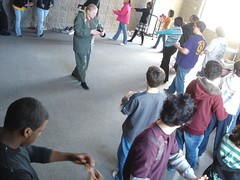Qigong or chi kung is an aspect of traditional Chinese medicine, some forms of which involve the coordination of different breathing patterns with various physical postures and motions of the body, says Wikipedia.org.
Qigong is mostly taught for health maintenance purposes, but there are also some who teach it as a therapeutic intervention or practice it as a medical profession.
Various forms of traditional qigong are also widely taught in conjunction with Chinese martial arts, and are especially prevalent in the advanced training of what are known as the Neijia, or internal martial arts where the object is the full mobilization and proper coordination and direction of the energies of the body as they are applied to facilitate all physical actions.
Qigong relies on the traditional Chinese belief that the body has something that might be described as an "energy field" generated and maintained by the natural respiration of the body, known as qi.
Qi means breath or gas in Chinese, and, by extension, the energy produced by breathing that keeps us alive; gong means work applied to a discipline or the resultant level of technique. Qigong is then "breath work" or the art of managing one's breathing in order to achieve and maintain good health, and (especially in the martial arts) to enhance the energy mobilization and stamina of the body in coordination with the physical process of respiration.
Attitudes toward the scientific basis (or lack of it) for qigong vary markedly. Most Western medical practitioners and many practitioners of traditional Chinese medicine, as well as the Chinese government, view qigong as a set of breathing and movement exercises, with possible benefits to health through stress reduction and exercise. Others see qigong in more metaphysical terms, claiming that breathing and movement exercises can help one tap the fundamental energies of the universe.
Tuesday, January 15, 2008
Subscribe to:
Post Comments (Atom)


No comments:
Post a Comment